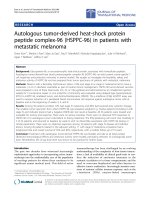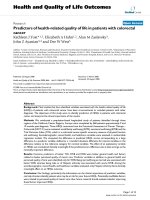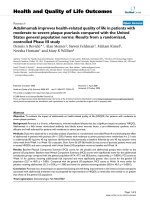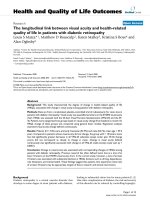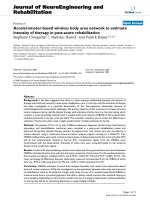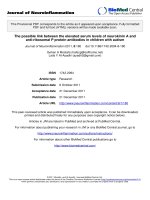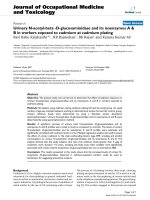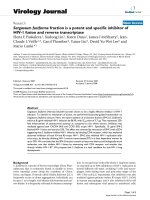báo cáo hóa học: " The longitudinal link between visual acuity and health-related quality of life in patients with diabetic retinopathy" doc
Bạn đang xem bản rút gọn của tài liệu. Xem và tải ngay bản đầy đủ của tài liệu tại đây (247.97 KB, 10 trang )
BioMed Central
Page 1 of 10
(page number not for citation purposes)
Health and Quality of Life Outcomes
Open Access
Research
The longitudinal link between visual acuity and health-related
quality of life in patients with diabetic retinopathy
Louis S Matza*
1
, Matthew D Rousculp
2
, Karen Malley
3
, Kristina S Boye
4
and
Alan Oglesby
2
Address:
1
Center for Health Outcomes Research, United BioSource Corporation, 7101 Wisconsin Avenue, Suite 600, Bethesda, MD 20814, USA,
2
Eli Lilly & Company, Indianapolis, IN, USA,
3
Malley Research Programming, Inc, Rockville, MD, USA and
4
Eli Lilly & Company, Indianapolis,
IN, USA
Email: Louis S Matza* - ; Matthew D Rousculp - ;
Karen Malley - ; Kristina S Boye - ; Alan Oglesby -
* Corresponding author
Abstract
Background: This study characterized the degree of change in health-related quality of life
(HRQL) associated with change in visual acuity among patients with diabetic retinopathy.
Methods: Data are from a randomized, placebo-controlled trial of ruboxistaurin for vision loss in
patients with diabetic retinopathy. Visual acuity was quantified as letters on the ETDRS visual acuity
chart. HRQL was assessed with the 25-Item Visual Function Questionnaire (VFQ-25) and the SF-
36. Patients were categorized into groups based on visual acuity change from baseline to month 18.
HRQL change of these groups was compared using general linear models. Regression analyses
examined visual acuity change defined continuously.
Results: Patients (N = 535) were primarily Caucasian (81.9%) and male (64.1%); mean age = 59.3
years. Compared to patients whose visual acuity did not change, the group with > 10 letters vision
loss had significantly greater decreases in all VFQ-25 subscales except ocular pain. SF-36 change
scores did not correspond as closely to change in vision. Change in visual acuity defined
continuously was significantly associated with change in all VFQ-25 scales except ocular pain (p <
0.0001).
Conclusion: Change in visual acuity was associated with corresponding changes in HRQL among
patients with diabetic retinopathy. Previous research has often defined vision loss as a loss of at
least 15 letters on the ETDRS visual acuity chart. In the current study, however, a loss of at least
10 letters was associated with substantial declines in HRQL domains such as driving, dependency,
role limitations, and mental health. These findings suggest that patients who experience vision loss
of at least 10 letters may be appropriate targets of future research and clinical intervention.
Background
Diabetic retinopathy is a retinal vascular disorder that
develops to some degree in most patients with diabetes,
leading to substantial vision loss for many patients [1-3].
Like other complications of diabetes, the risk and severity
of this disorder can be reduced by controlling hyperglyc-
Published: 7 November 2008
Health and Quality of Life Outcomes 2008, 6:95 doi:10.1186/1477-7525-6-95
Received: 15 April 2008
Accepted: 7 November 2008
This article is available from: />© 2008 Matza et al; licensee BioMed Central Ltd.
This is an Open Access article distributed under the terms of the Creative Commons Attribution License ( />),
which permits unrestricted use, distribution, and reproduction in any medium, provided the original work is properly cited.
Health and Quality of Life Outcomes 2008, 6:95 />Page 2 of 10
(page number not for citation purposes)
emia and hypertension [4-8]. However, epidemiological
research indicates that diabetic retinopathy remains com-
mon in patients with both type 1 and type 2 diabetes
[9,10]. For example, a pooled analysis of age population-
based high surveys estimated that 40.3% of adults 40
years and older with diabetes have retinopathy, and 8.2%
of the population has vision-threatening retinopathy [3].
In qualitative studies involving focus groups and semi-
structured interviews, patients have reported that diabetic
retinopathy and the associated vision loss have a substan-
tial impact on multiple domains of health-related quality
of life (HRQL), including independence, mobility, lei-
sure, and self-care activities [11,12].
Cross-sectional quantitative studies conducted at one
point in time have also found that diabetic retinopathy is
associated with impairment in functioning and overall
HRQL [13-16]. Studies conducted in patients with dia-
betic retinopathy and other diabetes-related visual prob-
lems such as macular edema suggest that the degree of
impact on HRQL is directly related to the reduction in vis-
ual acuity [13,17-19]. This inverse relationship between
visual acuity and HRQL is consistent with results of
research conducted among patients with a range of ocular
diseases including macular degeneration, glaucoma, and
cataract [13,17,20,21].
Although the association between visual acuity and HRQL
at one point in time has been well established, little is
known about this link over time. Thus, the purpose of the
current study was to examine the degree of change in
HRQL that is associated with visual acuity changes among
patients with diabetic retinopathy. Patients were catego-
rized into groups based on visual acuity changes during
the first 18 months of a clinical trial, and these groups
were compared with respect to change in both condition-
specific and generic HRQL measures.
Methods
Data source
Data are from a 36-month, randomized, double-masked,
placebo-controlled, parallel, multicenter trial of once-
daily ruboxistaurin for vision loss in patients with diabetic
retinopathy. The clinical findings and characteristics of
this trial have been reported previously [22]. A total of
684 patients were randomized at 70 clinical sites in the
United States. Randomized patients had type 1 or type 2
diabetes and HbA1c values ≤ 13%. To be eligible, patients
had to have at least one eye that met ocular entry criteria:
(a) Early Treatment Diabetic Retinopathy Study (ETDRS)
retinopathy levels of > 47A and < 53E; (b) test-corrected
visual acuity score of > 45 letters as measured by the
ETDRS visual acuity protocol [23]; (c) no history of pan-
retinal photocoagulation for diabetic retinopathy; (d) no
evidence of glaucoma; and (e) no history of conditions
affecting diabetes retinopathy progression. Ethical review
boards provided written approval of the study protocol
and the informed consent document. The study was initi-
ated at each site after the principal investigator and the
study sponsor obtained approval documents. The princi-
pal investigator at each site was responsible for obtaining
informed consent from each patient or legal representa-
tive and for obtaining the appropriate signatures on the
informed consent document prior to performing any pro-
cedures or administering any study drug.
Measures
National Eye Institute Visual Function Questionnaire – 25-item
version (VFQ-25)
This 25-item patient-reported questionnaire is a short
form of a 51-item survey designed to assess the influence
of visual impairment on health-related quality of life
(HRQL). The content of the original questionnaire was
derived from multi-condition focus groups [24]. The 25-
item version has been shown to have adequate reliability
and validity in a sample consisting of participants with
age-related cataracts, age-related macular degeneration,
diabetic retinopathy, primary open-angle glaucoma, or
cytomegalovirus retinitis [25]. The instrument has also
been shown to be strongly associated with vision, inde-
pendent of severity of retinopathy and other complica-
tions associated with type 1 diabetes [19]. In previous
studies, the VFQ-25 has been able to detect functional
impairment associated with a wide range of ocular condi-
tions [20,25-29].
The VFQ-25 yields a total score and 11 visual subscale
scores: general vision, ocular pain, near vision, distance
vision, social function, mental health, role limitations,
dependency, driving, color vision, and peripheral vision.
Each subscale score ranges from 0 to 100, with higher
scores representing better HRQL. The instrument also
includes a general health item. In this trial, the general
health item was completed only if patients did not com-
plete the SF-36, and consequently, results of this item are
not reported in the current paper. Consistent with the
developers' instructions and previous publications, the
total score was computed without including the general
health item.
Medical Outcomes Study (MOS) 36-Item Short Form Health Survey
(SF-36)
The SF-36 is a 36-item measure used to gather informa-
tion about the patient's perceived health. The 36 items are
completed by the patient and gather information about
eight health concepts: physical functioning, physical role
functioning, bodily pain, general health, vitality, social
functioning, emotional role functioning, and mental
health. Higher scores on the SF-36 indicate that the
patient has reported better-perceived health [30,31].
Health and Quality of Life Outcomes 2008, 6:95 />Page 3 of 10
(page number not for citation purposes)
Measure of visual acuity
Visual acuity was determined as part of an ophthalmo-
logic examination (including slit-lamp biomicroscopy,
intraocular pressure, and ophthalmoloscopy) at screening
and each study visit. Visual acuity was quantified in terms
of number of letters as measured by the Early Treatment
Diabetic Retinopathy Study (ETDRS) visual acuity proto-
col [23]. These scores have a possible range of 0 to 100 let-
ters, with higher scores indicating better visual acuity. For
the current analysis, visual acuity was defined at each time
point (i.e., baseline and month 18) as each individual's
ETDRS rating for his/her better eye (referred to as "best eye
ETDRS"), regardless of which eye is used at other time
points, and regardless of whether the best eye met criteria
for being included as a "study eye." Previous research has
found that binocular acuity can be inferred from measures
of monocular acuity in the better eye, particularly when
assessing functional impairment associated with visual
acuity, and separate assessment of binocular acuity is not
required [32].
Statistical analyses
The health outcomes measures used in the current analy-
sis were administered at baseline, month 18, and month
36. The current analysis focused on change from baseline
to month 18 because of the sample size limitations asso-
ciated with health outcomes data at month 36. Baseline
analyses, including descriptive statistics, were performed
using the sample of all enrolled patients. Analyses of
change in visual acuity and/or HRQL were performed
with the subset of patients who had at least one VFQ-25
subscale present at both baseline and month 18 (this sub-
set is called the "change analysis sample"). Analyses were
conducted to assess whether patients meeting this crite-
rion differed from patients who were excluded. The pri-
mary measure of HRQL in the study was the condition-
specific VFQ-25. Secondary analyses examined group dif-
ferences in the generic SF-36.
Descriptive analyses were conducted to summarize demo-
graphic/clinical variables, visual acuity (ETDRS), and
HRQL. The scoring of all questionnaires followed the
guidelines set forth by the instrument developers. Cate-
gorical variables were summarized in terms of frequencies
and percentages, and continuous variables were summa-
rized in terms of means and standard deviations. Prelimi-
nary analyses were conducted to examine reliability and
validity of the VFQ-25 to ensure that this instrument per-
formed adequately in patients with diabetic retinopathy.
Cronbach's alpha for each VFQ-25 scale was computed to
assess internal consistency reliability. Construct validity of
the VFQ-25 was examined with Spearman correlations
between the VFQ-25 scales and visual acuity at baseline
and month 18. In this study, correlations were interpreted
as small (0.10), moderate (0.30), or large (0.50) follow-
ing the guidelines proposed by Cohen [33].
The primary analyses focused on the link between visual
acuity (i.e., ETDRS) and HRQL (i.e., the VFQ-25 and to a
lesser extent, the SF-36) over time. This link was analyzed
with change in visual acuity defined both categorically
and continuously. First, categorical analyses were con-
ducted to characterize the HRQL decreases/gains associ-
ated with various degrees of change in visual acuity.
Patients were categorized into five groups based on
ETDRS change from baseline to month 18: Improved by ≥
10 letters, Improved by 5 to 9 letters, No change (-4 to +4
letters), Worsened by 5 to 9 letters, and Worsened by ≥ 10
letters. A series of 12 general linear models (GLMs) with
Scheffe's post hoc pairwise comparisons were conducted
to compare the VFQ-25 change scores of the five groups,
when controlling for age, gender, and baseline visual acu-
ity. In these models, the change group is a five-level inde-
pendent variable. Age and baseline visual acuity are
continuous covariates, and gender is a categorical covari-
ate. The dependent variables were change scores from
baseline to month 18. A parallel set of 12 models was con-
ducted with the SF-36 subscales as the dependent varia-
bles.
To examine the relationship between the VFQ-25 sub-
scales and visual acuity defined as a continuous variable,
12 additional GLMs were conducted. These models are
the same as those described above, except visual acuity
was entered as a continuous variable rather than a five-
level categorical variable.
Finally, as an exploratory descriptive analysis, change
scores for each VFQ-25 item were calculated for each of
the five ETDRS change groups. These scores are presented
to provide a rough indication of the precise areas of HRQL
and functioning that may tend to change along with vis-
ual acuity in patients with diabetic retinopathy.
SAS statistical software version 8.2 was used for all analy-
ses. All statistical tests were two-tailed and conducted with
significance level for testing fixed at 0.05.
Results
Sample characteristics
Baseline demographic and clinical characteristics for the
total sample (N = 684), change analysis sample (N = 535),
and patients excluded from the change analysis sample (N
= 149) are presented in Table 1. There were no statistically
significant differences between the change analysis sam-
ple and the excluded sample in age, gender, type of diabe-
tes, duration of diabetes, body mass index (BMI), or
baseline ETDRS. The only difference between the two
samples was in ethnicity, as the change analysis sample
Health and Quality of Life Outcomes 2008, 6:95 />Page 4 of 10
(page number not for citation purposes)
had a somewhat larger percentage of Caucasian patients.
The change analysis sample was primarily male (64.1%)
and Caucasian (81.9%), with a mean age of 59.3 years.
This sample was primarily diagnosed with type 2 diabetes
(88.0%), and the sample had a mean BMI of 32.8 at base-
line.
VFQ-25 and ETDRS descriptive statistics
Baseline descriptive statistics for the VFQ-25 are presented
in Table 2. Mean subscale scores ranged from 69.5 (gen-
eral vision) to 94.6 (color vision), and the total score was
84.1. At baseline, there was substantial heterogeneity in
the sample, with scores ranging from 0 to 100 in several
subscales. The multi-item subscales of the VFQ-25 gener-
Table 1: Baseline demographics and clinical characteristics
Characteristic Change analysis sample*
(N = 535)
Excluded (N = 149) Total sample (N = 684) p-value
†
Age (mean years, SD) 59.3 ± 10.8 59.3 ± 10.8 59.3 ± 10.8 0.97
Gender (n, %)
Male 343 (64.1%) 90 (60.4%) 433 (63.3%) 0.44
Female 192 (35.9%) 59 (39.6%) 251 (36.7%)
Ethnicity (n, %)
Caucasian 438 (81.9%) 94 (63.1%) 532 (77.8%) <0.0001
African descent 42 (7.9%) 28 (18.8%) 70 (10.2%)
East/Southeast Asian 21 (3.9%) 6 (4.0%) 27 (3.9%)
Hispanic 17 (3.2%) 20 (13.4%) 37 (5.4%)
Other 17 (3.2%) 1 (0.7%) 18 (2.6%)
Type of diabetes (n, %)
Type 1 64 (12.0%) 16 (10.7%) 80 (11.7%) 0.77
Type 2 471 (88.0%) 133 (89.3%) 604 (88.3%)
Duration of diabetes (years; mean ± SD) 16.3 ± 8.3 15.1 ± 7.5 16.0 ± 8.1 0.11
Body mass index (kg/m
2
; mean ± SD) 32.8 ± 6.9 32.8 ± 9.1 32.8 ± 7.4 0.95
ETDRS visual acuity rating
(letters; mean ± SD)
Best eye 81.3 ± 8.2 80.1 ± 8.6 81.1 ± 8.3 0.12
Worst eye 72.2 ± 15.0 69.3 ± 17.2 71.6 ± 15.6 0.06
Right eye 77.5 ± 12.2 75.6 ± 12.0 77.1 ± 12.2 0.08
Left eye 76.0 ± 13.6 73.9 ± 16.8 75.6 ± 14.3 0.15
*Patients with visual acuity assessment and at least one VFQ-25 subscale at both baseline and month 18
†
Continuous variables compared with t-tests; 2-level categorical variables such as gender compared with Fisher exact test; categorical variables with
more than two levels compared with chi-square analyses
ETDRS = Early Treatment Diabetic Retinopathy Study; SD = standard deviation; VFQ-25 = 25-Item Visual Function Questionnaire
Table 2: Distributional characteristics, internal consistency reliability, and construct validity of VFQ-25 scales at baseline
Scale N Mean SD Range Number of items Cronbach's alpha
†
Spearman correlations with
ETDRS
General vision 670 69.5 17.4 20.0 – 100.0 0.39***
Ocular pain 671 89.1 15.2 12.5 – 100.0 2 0.68 0.02
Near vision 671 75.8 21.7 8.3 – 100.0 3 0.81 0.38***
Distance vision 671 82.9 17.9 16.7 – 100.0 3 0.72 0.35***
Social function 671 93.9 12.9 12.5 – 100.0 2 0.64 0.25***
Mental health 671 77.2 21.3 0.0 – 100.0 4 0.79 0.28***
Role limitations 670 81.4 23.1 0.0 – 100.0 2 0.75 0.32***
Dependency 670 91.3 17.4 0.0 – 100.0 3 0.83 0.29***
Driving 632 81.1 20.7 0.0 – 100.0 3 0.73 0.34***
Color vision 665 94.6 14.7 0.0 – 100.0 0.12**
Peripheral vision 669 88.4 19.4 25.0 – 100.0 0.25***
Overall VFQ-25 score 671 84.1 13.5 16.2 – 100.0 25 0.93 0.40***
†
Computed only for multi-item scales
*p < 0.05; **p < 0.01; ***p < 0.001
ETDRS = Early Treatment Diabetic Retinopathy Study Visual Acuity Rating; SD = standard deviation; VFQ-25 = 25-Item Visual Function
Questionnaire
Health and Quality of Life Outcomes 2008, 6:95 />Page 5 of 10
(page number not for citation purposes)
ally had adequate internal consistency reliability. Cron-
bach's alpha was 0.68 for the ocular pain subscale, 0.64
for the social function subscale, and at least 0.72 for all
other subscales. Correlations with ETDRS visual acuity rat-
ing were statistically significant (p < 0.01) for all subscales
except ocular pain. The correlation coefficients were in the
moderate range (i.e., ≥ 0.30) for the total score and the
general vision, near vision, distance vision, role limita-
tions, and driving subscales. In the change analysis sam-
ple, mean best eye ETDRS visual acuity was 81.3 letters at
baseline (Table 1) and 81.4 letters at month 18.
The five change groups that are examined in the subse-
quent analyses were compared in terms of age and base-
line visual acuity. There were no significant differences
among the groups in age. However, there were some
group differences in baseline visual acuity. Baseline
ETDRS visual acuity ratings for the five groups were as fol-
lows: 72.2, Improved by ≥ 10 letters; 79.0, Improved by 5
to 9 letters; 83.0, No change (-4 to +4 letters); 81.5, Wors-
ened by 5 to 9 letters, and 79.9, Worsened by ≥ 10 letters.
The group that improved by ≥ 10 letters had significantly
worse baseline visual acuity than the other four groups (p
< 0.01). The only other significant difference was between
the group that improved by 5 to 9 letters and the no
change group (p < 0.01).
The association between visual acuity and HRQL
Results of GLMs examining the link between best eye
ETDRS visual acuity and the VFQ-25 are presented in
Table 3. Change in visual acuity was generally associated
with corresponding changes in most VFQ-25 scores. How-
ever, pairwise comparisons revealed no statistically signif-
icant differences in mean VFQ-25 change scores among
the two improvement groups and the no change group.
Compared with the improved by ≥ 10 letters group, the
worsened by 5 to 9 letters group had significantly different
change scores in the VFQ-25 dependency subscale and
total score. The group that worsened by ≥ 10 letters had
significantly different change scores than most of the
other groups, including the no change group, in all VFQ-
25 scales except ocular pain. There were no differences
among groups in the ocular pain.
A parallel set of models was conducted to assess whether
the five change groups differ in HRQL change as assessed
Table 3: ANCOVAs comparing VFQ-25 change scores among groups of patients differing in visual acuity change from baseline to
month 18†
Change in
VFQ-25 score
mean (SD)
Improved
by ≥ 10
(N = 32–35)
Improved
by 5 to 9
(N = 80–85)
No change
(-4 to +4)
(N = 300–323)
Worsened
by 5 to 9
(N = 47–53)
Worsened
by ≥ 10
(N = 36–39)
Overall
F value
Change in
best visual
acuity
p-value
Significant
pairwise
comparisons
General vision 9.1 (17.0) 3.3 (16.9) -0.2 (15.8) -1.5 (14.1) -13.3 (19.1) 5.98*** <0.0001 D***, G***, I***,
J*
Ocular pain 1.8 (15.2) -0.1 (16.3) 2.2 (14.8) 2.4 (13.9) 1.6 (15.0) 0.68 0.74
Near vision 6.3 (17.7) 3.6 (17.9) 1.1 (17.2) -4.5 (16.1) -15.8 (24.9) 6.16*** <0.0001 D***, G***, I***
Distance vision 2.7 (12.8) 1.4 (14.8) 0.3 (14.3) -5.6 (14.9) -16.2 (19.5) 8.45*** <0.0001 D***, G***, I***,
J*
Social function 2.9 (7.5) -0.9 (9.9) -0.5 (10.6) -3.3 (14.3) -11.2 (24.1) 5.24*** <0.0001 D***, G***, I***
Mental health 7.3 (17.9) 2.3 (15.1) 0.5 (16.9) -3.3 (22.9) -17.5 (28.1) 6.39*** <0.0001 D***, G***, I***,
J*
Role limitations 3.6 (15.6) 3.8 (21.0) 0.2 (17.9) -6.4 (23.6) -21.5 (31.4) 7.59*** <0.0001 D***, G***, I***,
J*
Dependency 3.3 (14.0) -3.0 (13.8) -0.3 (14.3) -7.5 (22.8) -26.1 (32.8) 13.35*** <0.0001 C*, D***, G***,
I***, J***
Driving 0.1 (18.9) -2.1 (14.1) -1.8 (15.4) -6.9 (19.1) -22.9 (35.1) 7.91*** <0.0001 D***, G***, I***,
J**
Color vision 2.3 (15.8) -1.5 (14.7) 0.6 (12.4) -3.8 (17.4) -11.5 (31.3) 3.56*** 0.0001 D*, G*, I***
Peripheral vision 5.7 (20.2) -2.6 (17.3) -0.5 (18.6) -5.0 (22.0) -16.7 (32.1) 4.52*** <0.0001 D***, G*, I***
Overall VFQ-25
score
3.9 (9.1) 0.2 (10.1) 0.1 (8.9) -4.4 (11.4) -15.6 (19.2) 13.99*** <0.0001 C**, D***, G***,
I***, J***
Pairwise comparisons:
A: Improved by ± 10 vs. Improved by 5 to 9; B: Improved by ± 10 vs. No change (-4 to +4);
C: Improved by ± 10 vs. Worsened by 5 to 9; D: Improved by ± 10 vs. Worsened by ± 10;
E: Improved by 5 to 9 vs. No change (-4 to +4); F: Improved by 5 to 9 vs. Worsened by 5 to 9;
G: Improved by 5 to 9 vs. Worsened by ± 10; H: No change (-4 to +4) vs. Worsened by 5 to 9;
I: No change (-4 to +4) vs. Worsened by ± 10; J: Worsened by 5 to 9 vs. Worsened by ± 10
†
Covariates: age in years, gender, best eye visual acuity at baseline
*p < 0.05; **p < 0.01; ***p < 0.001
ANCOVAs = analysis of covariance; SD = standard deviation; VFQ-25 = 25-Item Visual Function Questionnaire
Health and Quality of Life Outcomes 2008, 6:95 />Page 6 of 10
(page number not for citation purposes)
by SF-36 subscales (Table 4). Results suggest that change
in the SF-36 did not correspond as closely as the VFQ-25
to change in visual acuity. For example, the SF-36 reflected
slight declines in overall quality of life from baseline to
month 18, even among the groups that improved in visual
acuity. The only statistically significant pairwise compari-
son between groups was between the no change group
and the worsened by ≥ 10 letters group in the mental
health subscale.
In addition, 12 GLMs were conducted to examine the rela-
tionship between change in visual acuity defined as a con-
tinuous variable and change in the VFQ-25 scales,
controlling for age, gender, and visual acuity at baseline.
In all models, except the one with the VFQ-25 ocular pain
subscale as the dependent variable, change in visual acuity
was significantly associated with change in the VFQ-25
scale (p < 0.0001). Baseline visual acuity was also associ-
ated with the following four dependent variables: Dis-
tance Activities, Dependency, Driving, and the VFQ-25
total score (p < 0.05). Age and gender were not signifi-
cantly associated with the VFQ-25 scales in any of the
models.
Comparing change in individual VFQ-25 items among the
five ETDRS change groups
Mean change in each individual item of the VFQ-25 was
computed for each of the five groups from baseline to
month 18 (Table 5). In general, most individual items
tended to reflect improvement among the groups that
improved in ETDRS and worsening among the groups
that decline in ETDRS. Items that followed this logical pat-
tern included (item 2) present eyesight rating, (item 5)
difficulty reading newsprint, (item 6) seeing well up close,
(item 7) difficulty finding objects on a crowded shelf,
(item 8) difficulty reading street signs, (item 17) accom-
plish less due to vision, (item 18) work less due to vision,
and (item 21) frustrated due to vision.
Conclusion
Change in visual acuity was associated with change in
multiple domains of HRQL during this 18-month trial.
Categorical analyses suggested that patients with a loss of
10 letters on the ETDRS visual acuity chart (i.e., a two-line
loss) had significantly greater mean declines in nearly all
VFQ-25 scales than any other group of patients. Among
the other four visual acuity change groups, HRQL change
scores also followed logical patterns. For example, the
group with the greatest visual acuity improvement tended
to have the greatest gains in VFQ-25 subscale scores. How-
ever, differences in VFQ-25 scores among these four
groups were relatively small and mostly not statistically
significant.
Previous research has often defined vision loss as a loss of
at least 15 letters, which is the equivalent of three lines on
the ETDRS visual acuity chart [8,23]. Current results sug-
gest that a lower threshold may be used to define mean-
ingful vision loss. For example, a loss of at least 10 letters
was associated with substantial declines in key HRQL
domains such as driving, dependency, role limitations,
and mental health. These results are consistent with a pre-
vious study indicating that even mild to moderate visual
impairment has a notable impact on psychological func-
tioning [34]. Based on current results, patients who expe-
rience vision loss of at least 10 letters may be appropriate
targets of future research and clinical intervention.
Table 4: ANCOVAs comparing SF-36 change scores among groups of patients differing in visual acuity change from baseline to month
18†
Change in
SF-36
score mean (SD)
Improved
by ≥ 10
(N = 35)
Improved
by 5 to 9
(N = 85)
No change
(-4 to +4)
(N = 323)
Worsened
by 5 to 9
(N = 53)
Worsened
by ≥ 10
(N = 39)
Overall
F value
Change in
best visual
acuity
p-value
Significant
pairwise
comparisons
Physical functioning -4.0 (15.1) -4.5 (21.5) -2.9 (19.7) -5.1 (17.9) -5.7 (25.7) 1.88 0.96
Role-physical -10.7 (36.5) -3.5 (41.4) -9.2 (38.4) -6.6 (46.0) -21.2 (43.5) 2.14* 0.23
Role-emotional -6.7 (19.5) -6.7 (30.8) 1.1 (25.2) -3.1 (26.4) -2.6 (30.0) 1.31 0.20
Pain index -2.0 (23.0) -2.9 (25.5) -2.6 (24.7) -9.0 (22.5) -9.5 (29.0) 1.15 0.37
Mental health -1.5 (16.3) -1.5 (18.1) 0.4 (14.4) -0.8 (12.2) -8.4 (15.7) 2.67* 0.04 I*
Social functioning -5.0 (23.9) -1.8 (22.8) -3.1 (20.5) -4.2 (15.5) -9.0 (26.1) 2.04* 0.58
Vitality -4.7 (23.3) -4.2 (21.2) -2.7 (20.1) -3.6 (17.0) -6.5 (20.9) 2.26* 0.95
General health perceptions 1.3 (13.3) -2.0 (21.1) -1.6 (15.5) -2.3 (15.5) -8.3 (16.5) 3.32** 0.11
Physical component summary -1.4 (7.7) -1.3 (10.0) -2.2 (8.7) -2.9 (8.8) -4.5 (11.7) 2.31* 0.50
Mental component summary -1.5 (9.2) -1.2 (9.5) 0.3 (7.2) -0.4 (7.4) -2.6 (8.9) 1.85 0.35
Pairwise comparisons:
I: No change (-4 to +4) vs. Worsened by ± 10
†
Covariates: age in years, gender, best eye visual acuity at baseline
*p < 0.05; **p < 0.01; ***p < 0.001
ANCOVAs = analysis of covariance; SD = standard deviation
Health and Quality of Life Outcomes 2008, 6:95 />Page 7 of 10
(page number not for citation purposes)
Table 5: Mean change in individual items of the VFQ-25 for five groups of patients categorized by ETDRS change
Baseline to month 18
change in each item
of the VFQ-25
†
mean
(SD)
Five groups of patients categorized by ETDRS change from baseline to month 18
Improved by ≥ 10 (N
= 28–35)
Improved by 5 to 9
(N = 78–85)
No change (-4 to +4)
(N = 286–323)
Worsened by 5 to 9
(N = 45–53)
Worsened by ≥ 10 (N
= 27–39)
General vision
(Item 2)
9.1 (17.0) 3.3 (16.9) -0.2 (15.8) -1.5 (14.1) -13.3 (19.1)
Ocular pain
4. Amount pain 2.9 (24.1) 1.8 (22.8) 3.3 (19.5) 2.4 (19.2) 5.1 (20.0)
19. Amount time:
pain
0.7 (14.2) -2.1 (16.0) 1.2 (16.1) 2.4 (17.2) -1.9 (18.5)
Near vision
5. Reading normal
newsprint
9.6 (24.6) 5.5 (24.5) 1.0 (23.9) -1.4 (25.9) -14.5 (34.7)
6. Seeing well up
close
8.6 (25.7) 4.3 (25.1) 1.9 (22.7) -7.7 (20.1) -12.8 (26.8)
7. Finding objects on
crowded shelf
2.2 (21.6) 0.9 (19.6) 0.3 (20.8) -3.3 (20.8) -19.9 (31.0)
Distance vision
8. Reading street
signs
5.7 (24.3) 3.3 (22.2) -0.9 (20.1) -4.2 (23.4) -16.0 (29.0)
9. Going down stairs
at night
-0.8 (14.6) 0.0 (22.3) 0.6 (21.3) -5.2 (24.2) -10.9 (24.9)
14. Going out to
movies/plays
3.3 (10.9) -0.3 (16.7) 1.1 (15.8) -7.8 (23.7) -20.8 (27.1)
Social function
11. Seeing how
people react
2.3 (9.6) -0.6 (14.5) -0.5 (15.3) -6.7 (23.8) -13.5 (32.4)
13. Visiting others 3.7 (10.9) -0.6 (8.7) -0.5 (12.1) -1.0 (14.0) -9.0 (25.3)
Mental health
3. Amount true:
worry
6.4 (21.3) 9.4 (22.2) 4.7 (26.3) 0.0 (25.9) -8.3 (28.3)
21. Amount true:
frustrated
12.9 (33.4) 0.9 (25.7) 0.3 (27.7) -3.4 (41.7) -17.3 (37.7)
22. Amount true: no
control
7.9 (30.8) -0.6 (27.3) -1.8 (26.1) -6.7 (34.0) -21.8 (37.7)
25. Amount true:
embarrassment
2.1 (15.3) -0.6 (18.9) -1.1 (19.1) -2.9 (27.4) -22.4 (39.2)
Role limitations
17. Accomplish less 5.0 (27.7) 3.8 (25.7) -0.9 (22.8) -6.6 (26.9) -23.1 (34.1)
18. Limited in
endurance
2.1 (15.3) 3.8 (23.6) 1.3 (20.9) -6.1 (32.5) -19.9 (35.9)
Dependency
20. Stay home most
of time
5.7 (15.0) -2.6 (14.4) -1.0 (13.8) -5.3 (18.7) -21.8 (31.5)
23. Rely too much on
others' word
2.9 (18.0) -3.2 (18.0) 0.3 (20.8) -8.2 (32.0) -28.2 (39.0)
24. Need help from
others
1.4 (21.0) -3.2 (17.2) -0.2 (19.9) -9.1 (32.1) -28.2 (40.2)
Driving
15C. Daylight familiar
places
-0.8 (10.0) 1.6 (12.2) -1.7 (14.6) -4.8 (17.8) -25.0 (38.7)
16. Nighttime
familiar places
-0.9 (25.9) -5.7 (25.6) -0.8 (19.2) -6.1 (30.7) -7.1 (34.6)
16A. Difficult
conditions
-4.3 (24.2) -2.9 (20.9) -0.9 (20.5) -8.7 (21.9) -13.0 (32.1)
Color vision
12. Difficulty
matching clothes
2.3 (15.8) -1.5 (14.7) 0.6 (12.4) -3.8 (17.4) -11.5 (31.3)
Peripheral vision
10. Seeing objects off
to side
5.7 (20.2) -2.6 (17.3) -0.5 (18.6) -5.0 (22.0) -16.7 (32.1)
†
Three items of the VFQ-25 are not included in this table: 1 (general health), 15a (never driven/given up driving), and 15b (reason for giving up driving). Item 1 was
not completed by most participants in this study. Items 15a and 15b follow skip-patterns and are not rated on the same scale as the other items.
ETDRS = Early Treatment Diabetic Retinopathy Study; SD = standard deviation; VFQ-25 = 25-Item Visual Function Questionnaire
Health and Quality of Life Outcomes 2008, 6:95 />Page 8 of 10
(page number not for citation purposes)
This study also provides additional psychometric support
for the VFQ-25. Previously, this measure has been vali-
dated in samples combining patients with a range of eye
conditions including cataracts, macular degeneration, dia-
betic retinopathy, glaucoma, or low vision from any cause
[25,35]. In the current sample which consists entirely of
patients with diabetic retinopathy, all multi-item scales
demonstrated adequate internal consistency reliability. In
addition, all scales except ocular pain and color vision
demonstrated construct validity through significant corre-
lations in the moderate to large range with best eye visual
acuity. The two subscales with weaker correlations
assessed constructs that are not directly impaired by dia-
betic retinopathy and were not expected to be significantly
related to visual acuity. The VFQ-25 also demonstrated
responsiveness to change in visual acuity, particularly
among patients with vision loss of at least 10 letters. In
comparison to this condition-specific instrument, the
generic SF-36 seemed relatively unresponsive to change,
possibly because the SF-36 assesses a wide range of char-
acteristics that are not directly related to visual acuity. This
distinction between the two instruments is consistent
with previous research indicating that condition-specific
patient-reported outcome measures tend to be more
responsive to change than generic measures [36-38]. In
sum, the reliability, validity, and responsiveness demon-
strated in this study support the use of the VFQ-25 for
assessing HRQL among patients with diabetic retinopa-
thy, particularly in studies examining change over time.
Generic measures such as the SF-36 have other strengths.
For example, generic measures such as the SF-36 can be
used to make comparisons to the general population, esti-
mate the relative impact of various medical conditions,
and derive a utility value summarizing health status for
cost-effectiveness modeling [39-44]. Given the different
strengths of condition-specific and generic measures, the
choice of a patient-reported measure for any individual
study should take into account the study design, sample
characteristics, hypotheses, and aims.
Analyses were somewhat limited by the sample size. For
example, the group of 39 patients whose visual acuity
deteriorated by at least 10 letters is heterogeneous, with
visual acuity loss ranging from 10 to 52 letters (one
patient lost 52 letters, another lost 39 letters, and the other
37 patients lost between 10 and 27 letters). Analyses com-
paring subgroups of patients with different levels of vision
loss within this group of patients could help identify
whether there is a threshold beyond which HRQL is
affected. However, the current sample size is not large
enough to support division of these 39 patients into sub-
groups. Another limitation of this study is that sufficient
HRQL data are only available at two points in time (i.e.,
baseline and 18 months). Although the clinical trial did
extend to 36 months, there were not enough data at this
third time point to justify further analysis. Thus, the cur-
rent results do not provide insight into the ways visual
acuity and HRQL may change over time. These changes
may be gradual, but it is also possible that there is a point
in the process of visual acuity loss when most patients
begin to experience functional changes as well. Future
research with larger samples and assessments at multiple
time points is needed to better understand the link
between visual acuity and HRQL over time.
Despite these limitations, the current study provides
strong initial support for the hypothesis that visual acuity
loss is associated with a corresponding decline in HRQL
among patients with diabetic retinopathy. Importantly,
the findings suggest that visual acuity loss of at least 10 let-
ters is likely to have a significant impact on functioning.
Thus, in clinical settings, patients who decline to this
moderate degree should be questioned about functional
changes. Patients whose visual acuity loss has in fact
begun to affect their HRQL may benefit from early inter-
vention aimed at bolstering the affected functional
domains.
Abbreviations
ANCOVA: analysis of covariance; BMI: body mass index;
ETDRS: Early Treatment Diabetic Retinopathy Study;
GLM: general linear model; HRQL: health-related quality
of life; SD: standard deviation; SF-36: Medical Outcomes
Study (MOS) 36-Item Short Form Health Survey; VFQ-25:
25-Item Visual Function Questionnaire
Competing interests
LM works for UBC, a company that received funds from
Eli Lilly & Company for this research. KB is an employee
of Eli Lilly & Company. MR and AO were employees of Eli
Lilly & Company at the time this research was conducted.
KM is a subcontractor who received payment from UBC
for the time she spent working on this project.
Authors' contributions
LM co-directed this study and was the primary writer of
the manuscript. He played a key role in hypothesis gener-
ation, study design, statistical analysis, and data interpre-
tation. MR co-directed this study. He played a key role in
hypothesis generation, study design, statistical analysis,
data interpretation, and manuscript editing. KB and AO
assisted with hypothesis generation, study design, data
interpretation, and editing of the manuscript. KM per-
formed the statistical programming for this study.
Acknowledgements
The authors thank Jodi Shorr and Julie Meilak for production and editorial
assistance. This study was funded by Eli Lilly and Company.
Health and Quality of Life Outcomes 2008, 6:95 />Page 9 of 10
(page number not for citation purposes)
References
1. Fong DS, Aiello LP, Ferris FL 3rd, Klein R: Diabetic retinopathy.
Diabetes Care 2004, 27(10):2540-2553.
2. Frank RN: Diabetic retinopathy. N Engl J Med 2004, 350(1):48-58.
3. The Eye Diseases Prevalence Research Group: The prevalence of
diabetic retinopathy among adults in the United States. Arch
Ophthalmol 2004, 122(4):552-563.
4. Klein R, Klein BE: Relation of glycemic control to diabetic com-
plications and health outcomes. Diabetes Care 1998, 21(Suppl
3):C39-43.
5. Schrier RW, Estacio RO, Esler A, Mehler P: Effects of aggressive
blood pressure control in normotensive type 2 diabetic
patients on albuminuria, retinopathy and strokes. Kidney Int
2002, 61(3):1086-1097.
6. Stratton IM, Kohner EM, Aldington SJ, Turner RC, Holman RR,
Manley SE, Matthews DR: UKPDS 50: risk factors for incidence
and progression of retinopathy in type II diabetes over 6
years from diagnosis. Diabetologia 2001, 44(2):156-163.
7. The Diabetes Control and Complications Trial (DCCT) Research
Group: The effect of intensive treatment of diabetes on the
development and progression of long-term complications in
insulin-dependent diabetes mellitus. N Engl J Med 1993,
329(14):977-986.
8. UK Prospective Diabetes Study (UKPDS) Group: Tight blood pres-
sure control and risk of macrovascular and microvascular
complications in type 2 diabetes: UKPDS 38. BMJ 1998,
317(7160):703-713.
9. Roy MS, Klein R, O'Colmain BJ, Klein BE, Moss SE, Kempen JH: The
prevalence of diabetic retinopathy among adult type 1 dia-
betic persons in the United States. Arch Ophthalmol 2004,
122(4):546-551.
10. Williams R, Airey M, Baxter H, Forrester J, Kennedy-Martin T, Girach
A: Epidemiology of diabetic retinopathy and macular
oedema: a systematic review. Eye 2004, 18(10):963-983.
11. Coyne KS, Margolis MK, Kennedy-Martin T, Baker TM, Klein R, Paul
MD, Revicki DA: The impact of diabetic retinopathy: perspec-
tives from patient focus groups.
Fam Pract 2004, 21(4):447-453.
12. Woodcock A, Bradley C, Plowright R, Ffytche T, Kennedy-Martin T,
Hirsch A: The influence of diabetic retinopathy on quality of
life: interviews to guide the design of a condition-specific,
individualised questionnaire: the RetDQoL. Patient Educ Couns
2004, 53(3):365-383.
13. Knudtson MD, Klein BE, Klein R, Cruickshanks KJ, Lee KE: Age-
related eye disease, quality of life, and functional activity.
Arch Ophthalmol 2005, 123(6):807-814.
14. Sharma S, Oliver-Fernandez A, Bakal J, Hollands H, Brown GC,
Brown MM: Utilities associated with diabetic retinopathy:
results from a Canadian sample. Br J Ophthalmol 2003,
87(3):259-261.
15. Sharma S, Oliver-Fernandez A, Liu W, Buchholz P, Walt J: The
impact of diabetic retinopathy on health-related quality of
life. Curr Opin Ophthalmol 2005, 16(3):155-159.
16. Tung TH, Chen SJ, Lee FL, Liu JH, Lin CH, Chou P: A community-
based study for the utility values associated with diabetic
retinopathy among type 2 diabetics in Kinmen, Taiwan. Dia-
betes Res Clin Pract 2005, 68(3):265-273.
17. Brown MM, Brown GC, Sharma S, Landy J, Bakal J: Quality of life
with visual acuity loss from diabetic retinopathy and age-
related macular degeneration. Arch Ophthalmol 2002,
120(4):481-484.
18. Clarke PM, Simon J, Cull CA, Holman RR: Assessing the impact of
visual acuity on quality of life in individuals with type 2 diabe-
tes using the short form-36. Diabetes Care 2006,
29(7):1506-1511.
19. Klein R, Moss SE, Klein BE, Gutierrez P, Mangione CM: The NEI-
VFQ-25 in people with long-term type 1 diabetes mellitus:
the Wisconsin epidemiologic study of diabetic retinopathy.
Arch Ophthalmol 2001, 119(5):733-740.
20. Globe DR, Wu J, Azen SP, Varma R: The impact of visual impair-
ment on self-reported visual functioning in Latinos: the Los
Angeles Latino eye study. Ophthalmology 2004,
111(6):1141-1149.
21. Nirmalan PK, Tielsch JM, Katz J, Thulasiraj RD, Krishnadas R, Ram-
akrishnan R, Robin AL: Relationship between vision impairment
and eye disease to vision-specific quality of life and function
in rural India: the Aravind comprehensive eye survey.
Invest
Ophthalmol Vis Sci 2005, 46(7):2308-2312.
22. PKC-DRS2 Group: Effect of ruboxistaurin on visual loss in
patients with diabetic retinopathy. Ophthalmology 2006,
113(12):2221-2230.
23. Early Treatment Diabetic Retinopathy Study (ETDRS) Research
Group: Photocoagulation for diabetic macular edema. Early
treatment diabetic retinopathy study report number 1. Arch
Ophthalmol 1985, 103(12):1796-1806.
24. Mangione CM, Lee PP, Pitts J, Gutierrez P, Berry S, Hays RD: Psycho-
metric properties of the National Eye Institute Visual Func-
tion Questionnaire (NEI-VFQ). NEI-VFQ field test
investigators. Arch Ophthalmol 1998, 116(11):1496-1504.
25. Mangione CM, Lee PP, Gutierrez PR, Spritzer K, Berry S, Hays RD:
Development of the 25-item National Eye Institute Visual
Function Questionnaire. Arch Ophthalmol 2001,
119(7):1050-1058.
26. Cahill MT, Banks AD, Stinnett SS, Toth CA: Vision-related quality
of life in patients with bilateral severe age-related macular
degeneration. Ophthalmology 2005, 112(1):152-158.
27. Deramo VA, Cox TA, Syed AB, Lee PP, Fekrat S: Vision-related
quality of life in people with central retinal vein occlusion
using the 25-item National Eye Institute Visual Function
Questionnaire. Arch Ophthalmol 2003, 121(9):1297-1302.
28. Globe DR, Varma R, Torres M, Wu J, Klein R, Azen SP: Self-
reported comorbidities and visual function in a population-
based study: the Los Angeles Latino eye study. Arch Ophthal-
mol 2005, 123(6):815-821.
29. Ma SL, Shea JA, Galetta SL, Jacobs DA, Markowitz CE, Maguire MG,
Balcer LJ: Self-reported visual dysfunction in multiple sclero-
sis: new data from the VFQ-25 and development of an MS-
specific vision questionnaire. Am J Ophthalmol 2002,
133(5):686-692.
30. Ware JE Jr, Sherbourne CD: The MOS 36-item short-form
health survey (SF-36). I. Conceptual framework and item
selection. Med Care
1992, 30(6):473-483.
31. Ware JE Jr, Snow KK, Kosinski M, Gandek B: SF-36 Health Survey:
Manual and Interpretation Guide. Volume 11. Boston: The
Health Institute, New England Medical Center; 1993:11-11.
32. Rubin GS, Munoz B, Bandeen-Roche K, West SK: Monocular ver-
sus binocular visual acuity as measures of vision impairment
and predictors of visual disability. Invest Ophthalmol Vis Sci 2000,
41(11):3327-3334.
33. Cohen J: Statistical power analysis for the behavioral sciences.
2nd edition. Hillsdale, NJ: Lawrence Erlbaum Associates; 1988.
34. Wulsin LR, Jacobson AM, Rand LI: Psychosocial correlates of
mild visual loss. Psychosom Med 1991, 53(1):109-117.
35. Toprak AB, Eser E, Guler C, Baser FE, Mayali H: Cross-validation
of the Turkish version of the 25-item National Eye Institute
Visual Functioning Questionnaire (NEI-VFQ 25). Ophthalmic
Epidemiol 2005, 12(4):259-269.
36. Kalpaklioglu AF, Kara T, Kurtipek E, Kocyigit P, Ekici A, Ekici M: Eval-
uation and impact of chronic cough: comparison of specific
vs generic quality-of-life questionnaires. Ann Allergy Asthma
Immunol 2005, 94(5):581-585.
37. Leong KP, Yeak SC, Saurajen AS, Mok PK, Earnest A, Siow JK, Chee
NW, Yeo SB, Khoo ML, Lee JC, Seshadri R, Chan SP, Tang CY, Chng
HH: Why generic and disease-specific quality-of-life instru-
ments should be used together for the evaluation of patients
with persistent allergic rhinitis. Clin Exp Allergy 2005,
35(3):288-298.
38. Wiebe S, Guyatt G, Weaver B, Matijevic S, Sidwell C: Comparative
responsiveness of generic and specific quality-of-life instru-
ments. J Clin Epidemiol 2003, 56(1):52-60.
39. Coons SJ, Rao S, Keininger DL, Hays RD: A comparative review
of generic quality-of-life instruments. Pharmacoeconomics 2000,
17(1):13-35.
40. Graue M, Wentzel-Larsen T, Hanestad BR, Batsvik B, Sovik O: Meas-
uring self-reported, health-related, quality of life in adoles-
cents with type 1 diabetes using both generic and disease-
specific instruments. Acta Paediatr 2003, 92(10):
1190-1196.
41. Guyatt GH, Feeny DH, Patrick DL: Measuring health-related
quality of life. Ann Intern Med 1993, 118(8):622-629.
42. Kaplan RM, Groessl EJ, Sengupta N, Sieber WJ, Ganiats TG: Com-
parison of measured utility scores and imputed scores from
Publish with BioMed Central and every
scientist can read your work free of charge
"BioMed Central will be the most significant development for
disseminating the results of biomedical research in our lifetime."
Sir Paul Nurse, Cancer Research UK
Your research papers will be:
available free of charge to the entire biomedical community
peer reviewed and published immediately upon acceptance
cited in PubMed and archived on PubMed Central
yours — you keep the copyright
Submit your manuscript here:
/>BioMedcentral
Health and Quality of Life Outcomes 2008, 6:95 />Page 10 of 10
(page number not for citation purposes)
the SF-36 in patients with rheumatoid arthritis. Med Care
2005, 43(1):79-87.
43. Leidy NK, Revicki DA, Geneste B: Recommendations for evalu-
ating the validity of quality of life claims for labeling and pro-
motion. Value in Health 1999, 2(2):113-127.
44. Neumann PJ, Goldie SJ, Weinstein MC: Preference-based meas-
ures in economic evaluation in health care. Annu Rev Public
Health 2000, 21:587-611.
